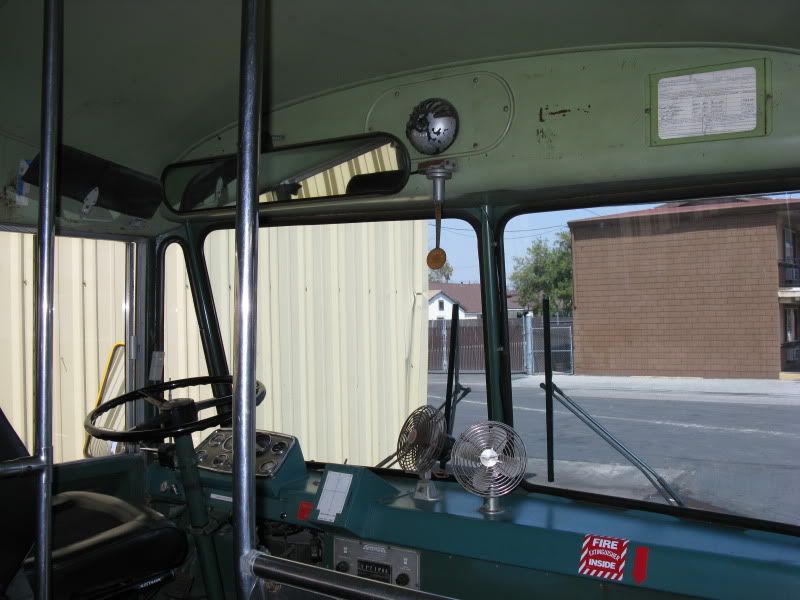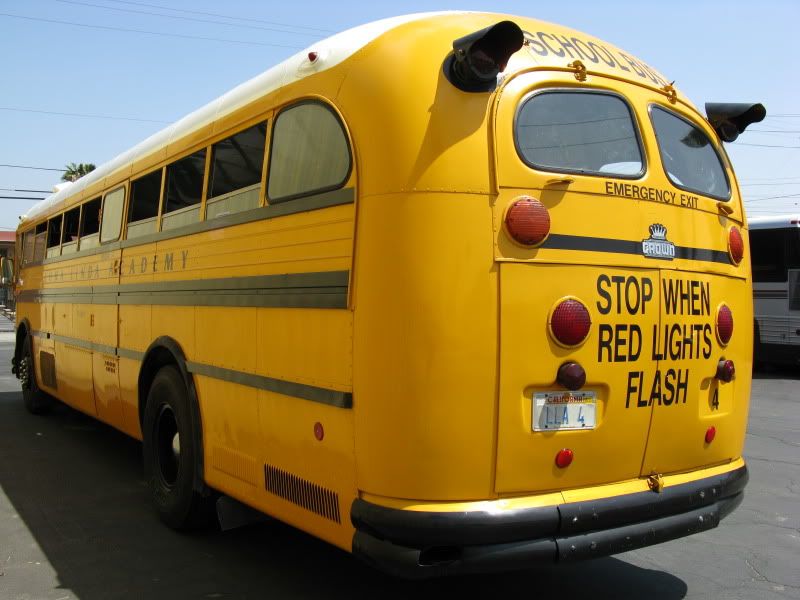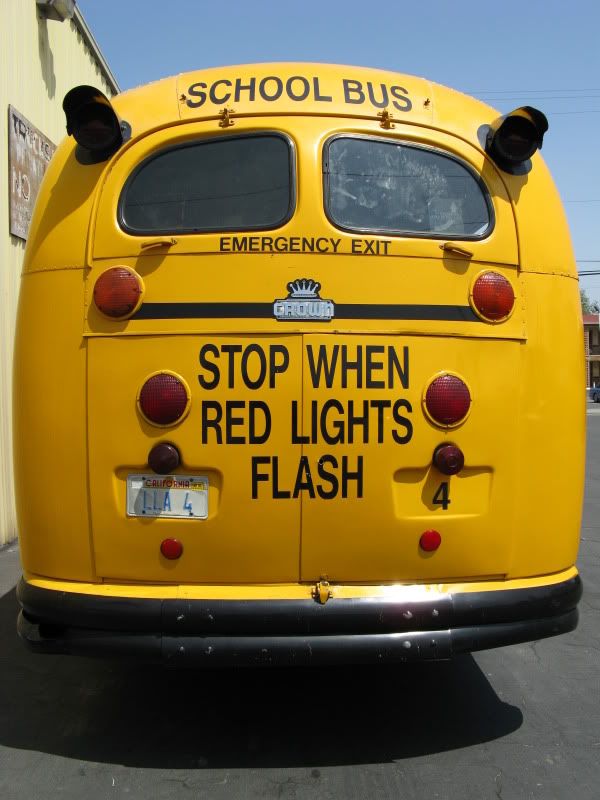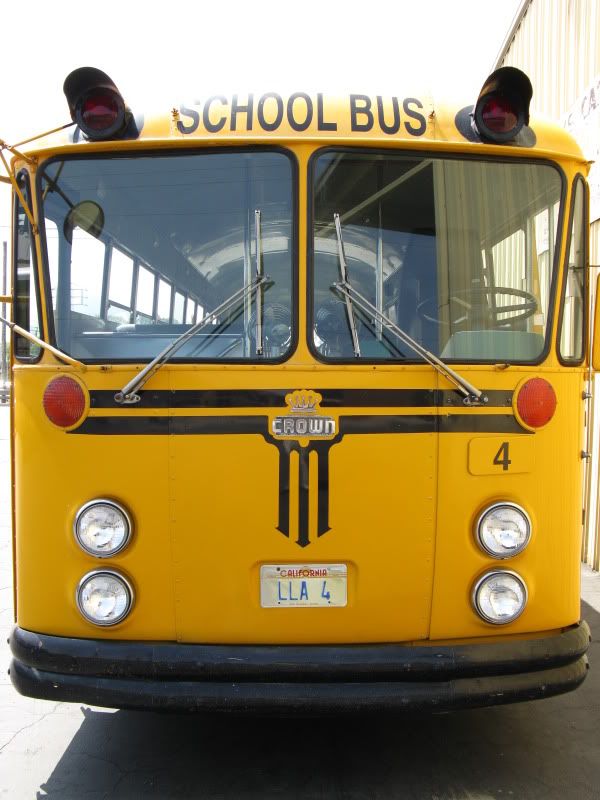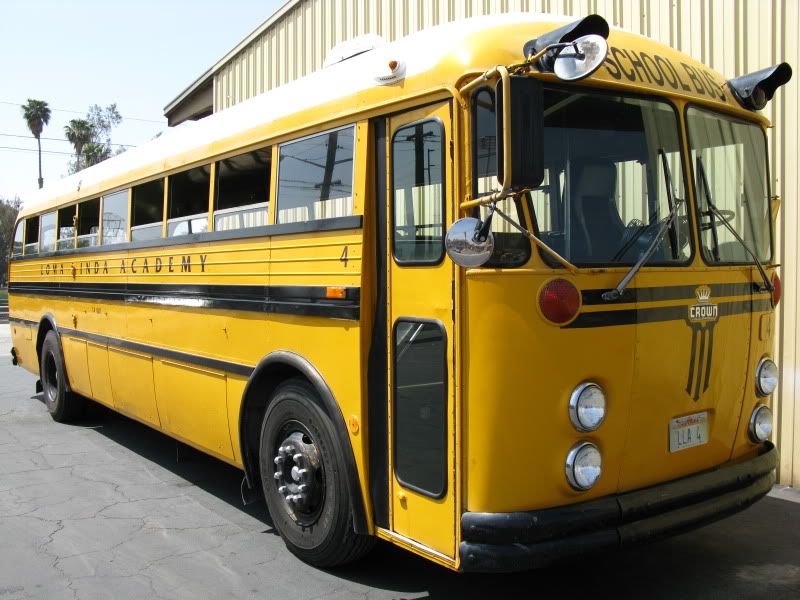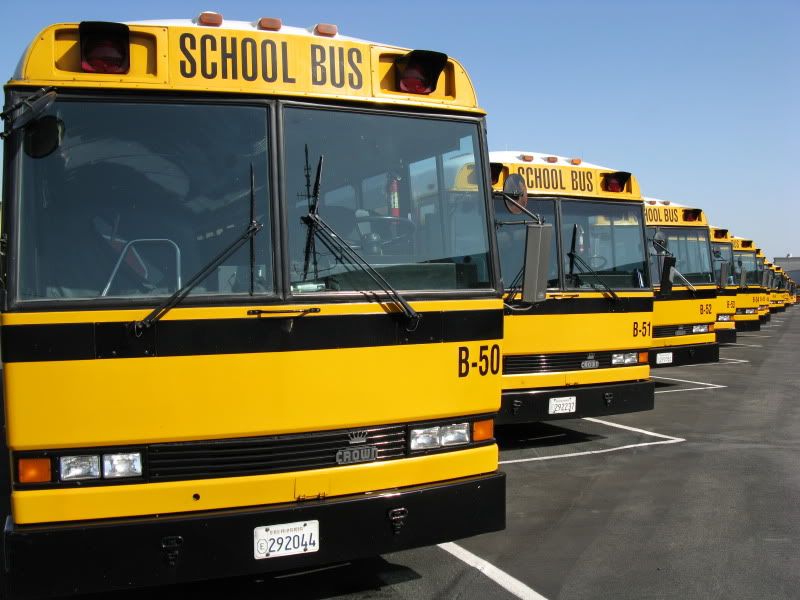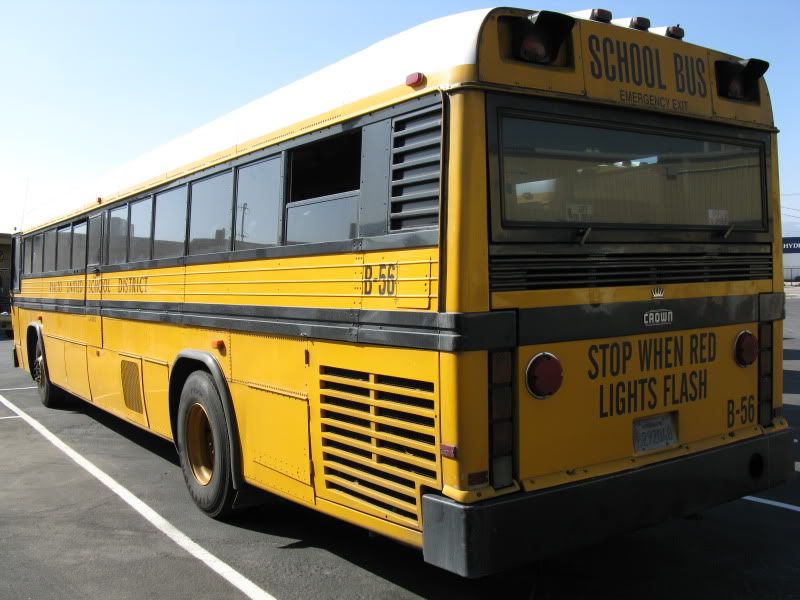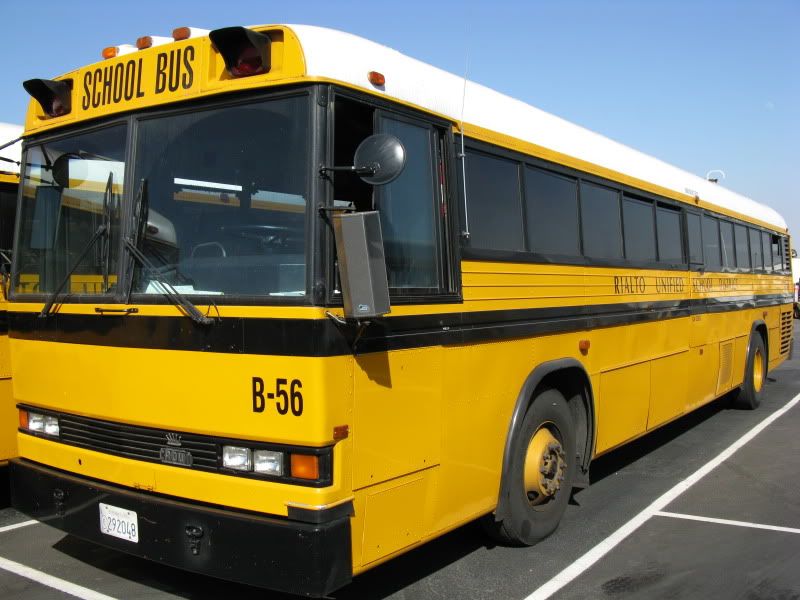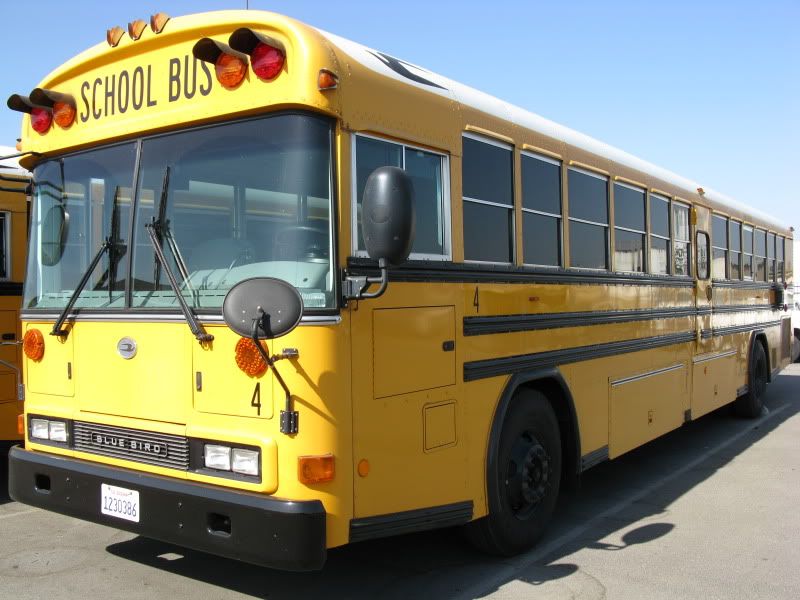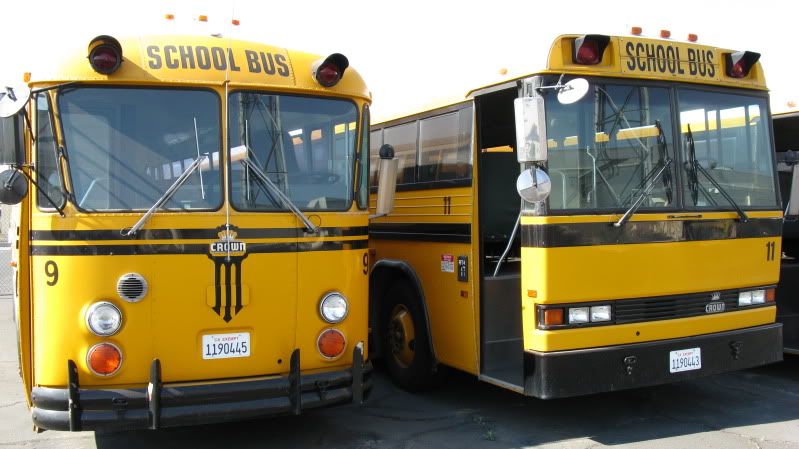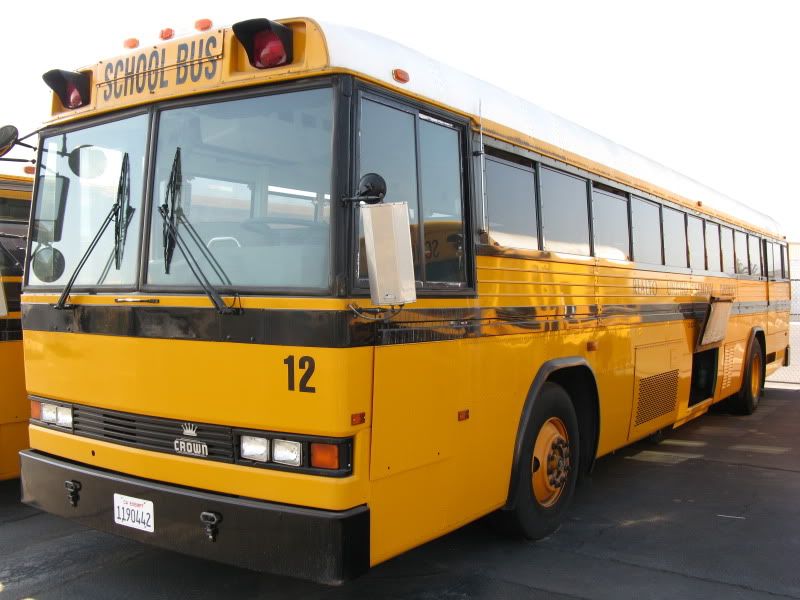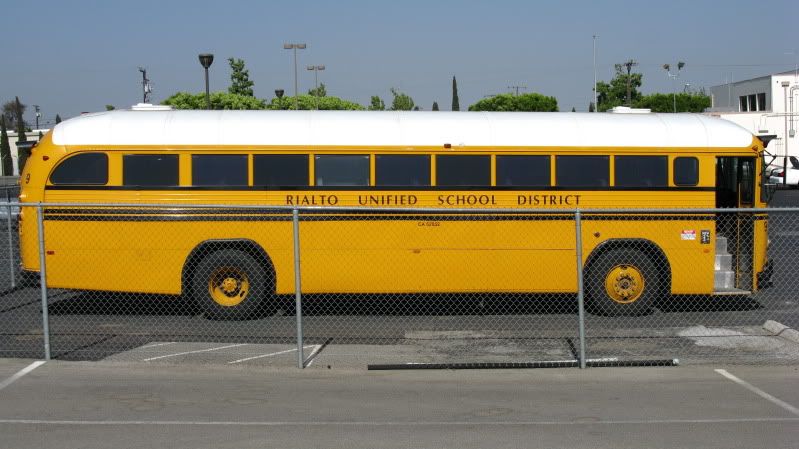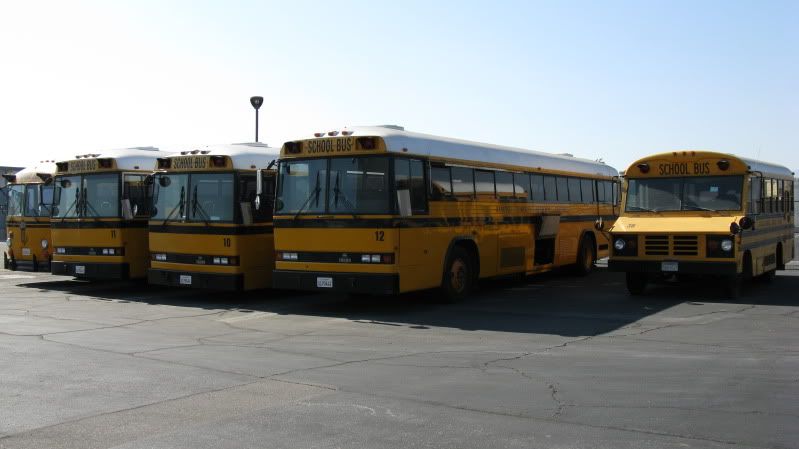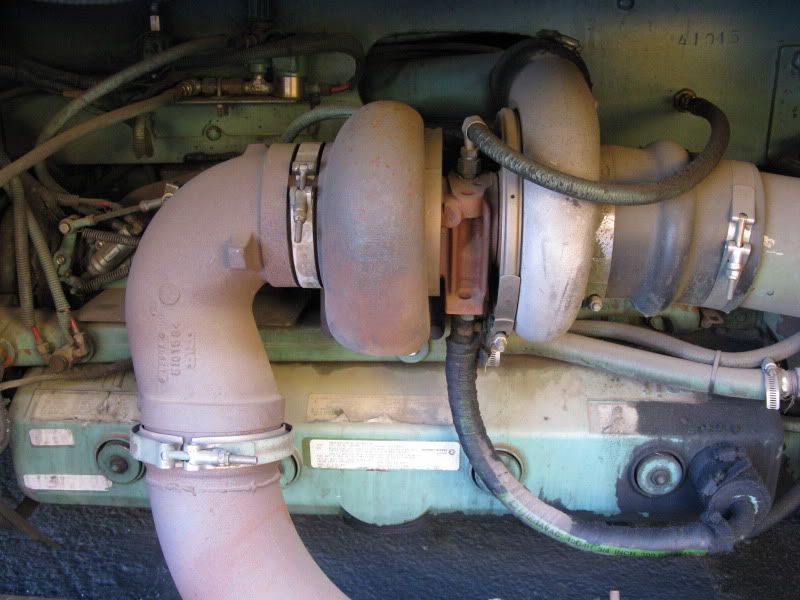Professor
A-List Customer
- Messages
- 467
- Location
- San Bernardino Valley, California

If you grew up in California, Oregon, or Washington between 1950 and 1990, chances are pretty good that you rode to school in a school bus made by the Crown Coach Corporation of Los Angeles, California. And chances are also pretty good that if there was a fire, medical emergency, or auto accident in your neighborhood, the fire engine that responded to that emergency was also made by the Crown Coach Corporation.
Crown was an unusual company in many respects. First, it was run by three generations of the same family: founder, son, and grandson. Second, the management and every employee took a fierce pride in quality of workmanship and dedication to customer service. In this era of cheap plastic products that break the day after the warranty expires, and when today’s customer service starts with “For English, Press 1” and ends with being parked on hold for 30 minutes to annoying elevator music, or being directed to a completely useless FAQ web page, words like "quality" and "customer service" sometimes seem like a foreign language now. At Crown, these weren’t just words, but a way of life.
In 1904 Don Brockway established the Crown Carriage Company, in a small wooden shed. A larger and sturdier brick factory was built at 6th and Los Angeles Streets in 1910. Both of the company’s first two factories bore the simple but catchy marketing slogan “Business Wagons for Business Men” on the front wall of the building. In those days, the power source of choice was still the humble horse.
Around 1910, motor trucks began to replace horses as the preferred motive power for heavy hauling. Don Brockway reluctantly began making truck bodies to mount on motor truck chassis, but he somewhat stubbornly refused to believe that the horse could ever really be replaced.
In 1916, Crown began building transit buses with open-air wood bodies, mounted on the then-popular Federal truck chassis. But horse-drawn business wagons continued to be the main focus of Don Brockway’s manufacturing efforts.
That began to change after the end of World War I in November, 1918. Soon after, Don’s son, Murillo Brockway, returned from Navy service. By year’s end, Crown had built enclosed-body school buses for two California school districts: Visalia High School and Tustin Union High.
In 1919, another event occurred in Los Angeles that would later prove important in Crown’s story. In that year, the Kinner Airplane and Motor Corporation was founded, with its factory at Tweedy and Long Beach Blvd. in Los Angeles. In 1920, Kinner introduced its Airster biplane, with a 28-foot wingspan, 21’4” length, and a 60-horsepower engine (which was increased in 1927 to 100 horsepower). The Airster could carry a load up to 450 pounds, and had a 420-mile flight range. The prototype Airster biplane crashed, but the second Kinner Airster, named The Canary, was sold for $2,500 to Amelia Earhart.
In 1921, Murillo Brockway officially joined his father’s carriage and truck-body firm. Murillo could see what his father couldn’t, that gasoline motors were the future. Murillo persuaded his dad there was a good market for making gasoline-powered buses. Don Brockway could hardly deny how increasingly common the sight of motor buses was in Los Angeles streets. Especially school buses carrying children to the increasing number of public and private schools being built in the growing city and its suburbs.
And so Murillo Brockway developed and oversaw a project to build Crown school-bus bodies, and to mount them on the popular Reo and Diamond T truck chassis, plus the locally-built Moreland truck chassis, which had been in production in a Burbank factory since 1911. Moreland Trucks would later become an important part of the Crown Company’s history, too.
Crown employees assigned to the motor bus division found the first name of their new boss, Murillo Brockway, difficult to remember and pronounce, so they nicknamed him “Brock.” The second-generation Brockway at Crown would be fondly known as “Brock” to his dying day, and retired Crown employees I spoke with still call him “Brock” today.
Brock’s decision to enter the motor bus business, specializing in school buses, turned out to be the correct one. In 1923, to meet growing demand for buses, Crown moved into its third factory, a much larger structure on San Julian Street in Los Angeles, which was named the "Brockway Building." Production switched entirely to bodies for commercial motor trucks, plus school buses and transit buses.
With this move, horse-drawn vehicles were dropped from the company’s product line, and the company motto on the building changed from “Business Wagons for Business Men” to “Business Bodies for Business Men.” Despite this shift, the company name was still Crown Carriage Company. The new factory was on its own railroad siding, so new Crown trucks and buses could be shipped to customers all over the western U.S.
Just before the move to the new factory, and the change in product focus from horse-drawn to motor vehicles, Murillo Brockway’s son, Robert M. “Bob” Brockway was born on November 21, 1922.
In 1925, Kinner Airplane began making monoplanes (single-wing aircraft), and Crown obtained exclusive rights to manufacture and sell Kinner Airster biplanes.
In 1927, Crown built the world’s first school bus with dual rear wheels, an important step toward larger passenger capacities. Mounted on a Reo truck chassis, its windows were roll-down canvas curtains, not window glass. The first of these new school buses was sold to Compton Union High School in Compton, California.
Also in 1927, Crown Carriage Company became Crown Motor Carriage Company, Inc. This new name was more reflective of its product line, which now included “auto trucks, commercial deliveries, auto truck cabs and bodies, paint shop, commercial designing and lettering, auto blacksmithing, forgings, and repair.”
1929 saw a big change in the aircraft division at Crown. For the first time, the Kinner Airster biplanes sported the Crown brand name, and were designated Crown Model B-3. But then the stock market crashed on October 29, 1929, hurling the nation into the Great Depression, where one-third of all Americans became unemployed. The stock-market crash sent Kinner Airplanes into a tail-spin, jeopardizing Crown’s licensing agreement with Kinner. You can’t license from a company that no longer exists!
Kinner Airplane was recapitalized in 1930 by Holley Carburetor of Detroit, temporarily saving Crown’s airplane division. In 1933, Kinner became Security-National Aircraft Corporation, with a new factory in Downey, CA. The licensing agreement with Crown was canceled, and after 8 years, Crown was out of the airplane business forever.
In 1930, Crown introduced a 43-passenger school bus mounted on Mack Truck chassis. For the first time, Crown buses had metal instead of wood bodies, and the framing was aero steel—probably obtained from Kinner Airplanes. The windows were all-metal, drop-sash type, eliminating the antiquated roll-up curtains.
In 1932, M.M. “Brock” Brockway took over day-to-day operations at Crown, although his father, Don Brockway, continued to be the president until 1945. Brock wasted no time introducing big changes.
That year, Crown unveiled the nation’s first school bus with all-steel body and “integral” design—meaning that the body and chassis were welded into one unit, for greater strength and improved safety of the student passengers. Another innovation was “protex” safety glass, with wire mesh molded into the center of the glass panel, for greater resistance to shattering.
The driver’s cab was mounted over the engine and radiator, for improved visibility. The first of these new school buses was built in 1932 for the Compton School District in Compton, CA. When this bus was retired in the 1950s, after more than 20 years of service, Bob Brockway bought this first-ever Crown “cab forward” school bus. Bob reports that its current owner stores this historic bus in a southern California repair shop, awaiting restoration.
In 1933, the corporate name changed to Crown Body and Coach Corporation.
Crown’s last venture into conventional front-engine school buses was a fleet of a dozen “Metro” school buses on Reo truck chassis for the Los Angeles City School District in 1935. Although they had steel bodies, they did not have the integral body/chassis design, and the engine was forward and to the right of the driver, reducing visibility and producing a tremendous amount of heat in the driver’s cab.
Also in 1935, Crown introduced its “Super Coach” school bus, with integral body and chassis, all-steel construction, air brakes on all wheels, and forward cab. Their 11 rows of forward-facing seats could carry 67 high-school or 78 elementary-school students. The first of these went to California’s El Monte Union High School.
In 1936, Crown made its first-ever fire engine, mounted on a White Trucks chassis, for the Los Angeles National Forest. It would be another 15 years before fire engines would become a significant part of the Crown product line.
1937 improvements to the Super Coach school bus included using a midship-mounted Hall-Scott engine carried under the school-bus floor, and an increase in capacity to an unprecedented 79 students.
The new Super Coach was such a hit that demand soon outstripped the production capacity of the San Julian Street factory.
In 1939, Crown acquired the chassis department of Moreland , which had been building trucks in Burbank, CA, since 1911. Moreland had supplied a few chassis on some of Crown’s early buses, but by 1939 the financial strain of the Great Depression had sent Moreland, like many small manufacturers, into oblivion. The combined Crown and Moreland operation now moved into a new factory at 2500 MacPherson Street, later renamed East 12th Street. This factory would be Crown’s home until 1984.
More improvements to the Crown Super Coach were made in 1940. Based on the long experience of Moreland in the truck chassis business, many improvements were made to the Crown school bus chassis. In addition, the engine moved to the rear, an escape window was added at the rear, and an emergency exit door on the right. The headroom at the seats and in the center aisle was increased.
Also in 1940, Crown introduced what may have been America’s first stretch limo. A 1940 Ford was stretched out to have four rows of plush padded bench seats, with arm rests on all seats, and 8 doors, the rear two doors being rear-opening “suicide doors.”
World War II—1941 to 1945—were very slow years for Crown. Government regulations restricted vehicle manufacturers like Crown from making vehicles for most non-government customers. Unlike better-known vehicle manufacturers such as Ford, Dodge, and GMC, government orders at Crown were scarce. For example, the army asked Crown to build a few fire engines, which were mounted on Ford/Marmon-Herrington chassis.
During World War II, Bob Brockway—grandson of Crown founder and president Don Brockway—attended dental school, graduating about the time the war ended. Before Bob could establish his dental practice, grandpa Don died in 1945, and Bob’s father, “Brock” Brockway took over as president of Crown Coach. Bob soon found himself working in the engineering department of his father’s company.
Many soldiers who served in World War II were stationed in southern California at some time during their service, either for training or to be shipped off to various Pacific island battles. Many liked the area so well that, on returning from service, they settled in Ventura, Los Angeles, and Orange Counties with their wives and families. Many new suburban communities arose, and these sprawling new communities needed buses to transport all of the “baby boomer” children to all the new schools. So business at Crown, painfully light during the war years, suddenly boomed in the postwar prosperity. Bob Brockway and his father were kept pretty busy.
Besides their staple school-bus business, Crown had also branched out to make city transit buses, inter-city buses, and specialized buses, including “mail-packet” buses. Postal clerks sorted mail in these buses, while traveling between cities, much as they had done aboard horse-drawn Crown mail-packet wagons two generations earlier.
In 1946, Bob recalled, Crown built a combination 12-passenger, mail, and freight bus for Bangor & Aroostook Railroad in far-off Maine. This was an unusual vehicle, and it was a great source of pride for Bob that the Crown reputation for quality had spread to the opposite end of the country.
In 1947, Crown once more ventured into the fire engine business, with a pumper on International Harvester (IH) chassis for Monterey, CA. But unlike buses, fire engines were still an insignificant factor in Crown’s bottom line.
In 1949, Roy Hardy, an executive at the Mack Tucks plant in Los Angeles was growing increasingly unhappy with working for Mack, and he negotiated with “Brock” Brockway to join the Crown Coach team.
Two years earlier, the American-LaFrance Fire Engine Company of Elmira, NY, had introduced its “700 Series” fire engines, the first cab-ahead-of-engine fire engines to be manufactured in any significant volume. Roy Hardy, the new kid at Crown, had an idea that Crown could compete with American-LaFrance in the fire engine business, at least in southern California, by adapting the cab-forward Crown school bus cab and chassis to a fire engine, but with the same standards of high quality for which the Crown name had long been known. At the time, American-LaFrance (ALF) had a reputation for low quality, in line with its low prices (ALF was generally the low bidder in municipal fire apparatus sales). Roy Hardy thought that building a cab-forward fire engine, similar to the popular ALF 700 Series but with very high standards of quality, could open up a new market for the Crown Corporation, and Brock agreed. With Brock’s blessing, Hardy and several Crown craftsmen began work on a prototype.
While Crown was developing its new fire engine division, things weren’t exactly stagnant in the bus business, either. In 1950, Crown rounded the front, rear, and sides of its popular Super Coach school bus. The new design looked better and was safer. The high-crowned roof provided an impressive 76 inches of center-aisle head room—not many elementary and high school students are 6’4” tall …in 1950, or today! Downey, California, bought the first of thousands upon thousands of these rounded-front Crown school buses, which would be built over the next 40 years.
This is the type of school bus nearly every California school child of the 1960s and 1970s fondly recalls today, and whole fleets of them still serve many west coast school districts. For example, Porterville (near Bakersfield) still uses 28 of them, many over 30 years old!
In 1951, Bob Brockway, not yet 29 and newly married, was drafted into the Army. The Korean War was already well underway, and would last until 1953. Bob was given the rank of Lieutenant, but his two years of duty weren’t in Korea—he was sent to serve as an Army dentist in France.
Shortly after Bob Brockway was shipped off to France, Roy Hardy finally finished the prototype fire engine with the Crown school bus cab and chassis. It had been in development for two years!
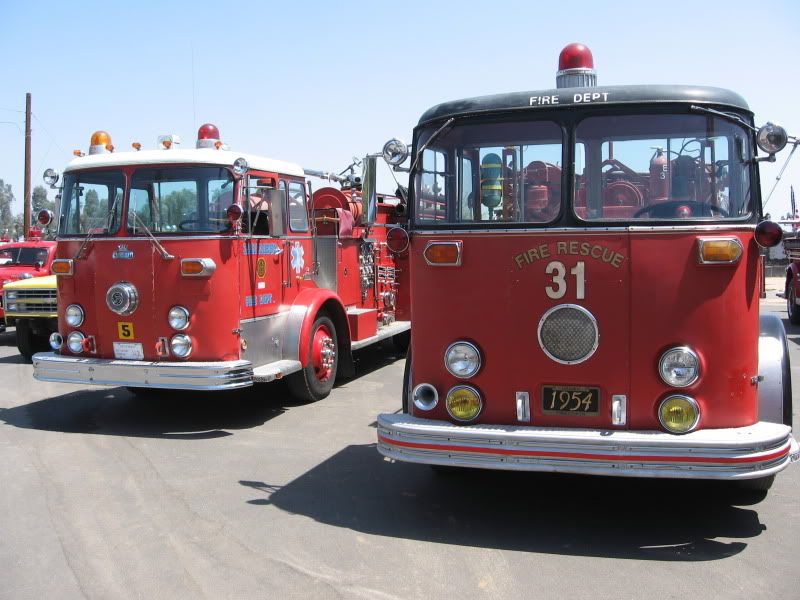
The new fire engine line, dubbed Crown Firecoach, would be in production for 34 years. In addition to sales all over California, Oregon, Washington, Idaho, Arizona, and Nevada, Crown Firecoach fire engines would see service in New Jersey, Illinois, Hawaii, Mexico, and even Kuwait! After retirement, Crown Firecoaches would find new homes with private collectors in nearly every U.S. state, and even as far away as Scotland and New Zealand.
The prototype Crown Firecoach fire engine, completed in 1951 and designated serial number F-1001(F for Firecoach) remained at the Crown factory for another two years, before it was finally sold to West Covina, California. Today, this historic first Crown Firecoach is privately owned by a collector of antique fire engines in Oregon City, Oregon.
With the Crown Firecoach line gearing up for quantity production in 1953, Richard Kearny Willmore—known as “Red” for his hair color—was promoted from head of school bus sales, where he had been since 1943. His new title was Manager of the Crown Firecoach Division. Roy Hardy, who had designed the Firecoach fire engine, reported to Red Willmore, who in return reported directly to Brock Brockway.
When Bob and Merle Brockway returned from his Army Dentist duty in France in 1953, Bob’s dad gave him a choice: either establish his own dental practice, or go back to work at Crown. So in 1954, Bob became Executive Vice President of Crown Coach Corporation. Crown already was top-heavy with vice presidents of engineering, marketing, sales, etc., but Bob was the top vice president over all of them.
In 1954, Crown built the first-ever diesel-powered, transit-type school bus. Powered by a horizontal, under-the-floor Cummins diesel engine, it was sold to Lakeside Elementary School in Bakersfield, CA. Less than a year later, Crown followed-up with the first-ever 91-passenger school bus (recall that 20 years earlier, a seating capacity over 60 was considered huge).
1956 saw the introduction of 10-inch brakes, for an unprecedented 1555-square-inch braking surface. Again, unlike today, quality and safety were more important considerations than costs and profits. These brakes became standard on all Crown buses and fire engines built after 1958.
In 1957, Bob oversaw the engineering and production of four special Firecoach fire engines that were shipped to Kuwait. Among other unique features of these fire engines were special stainless-steel water tanks that allowed them to pump salt water from the Persian Gulf. With the exception of one damaged in the 1990 Persian Gulf war, all four were in continuous firefighting service for over 40 years.
1957 was also the first and only time that Crown merged its fire engine and bus-building experience, building a special small (only 33 passenger) bus for the Los Angles City Fire Department—the only Crown bus ever to sport the Firecoach brand name. This unique bus/fire engine was restored in 2000 and is privately owned.
In 1962, “Brock” Brockway died, and Bob followed in his father’s footsteps, to become president of the company his grandfather had founded in 1904.
After the 1965 riot in the Watts section of Los Angeles, new federal laws and regulations mandated busing school children to integrate schools. As a result of these laws, Crown school bus sales skyrocketed. School bus demand quickly outstripped the factory’s production capacity, and Crown began buying up every building in the neighborhood, until the factory occupied the entire city block. The fire engine production was moved into its own section of the growing factory, at 2428 East 12th Street, while the bus division remained at 2500 East 12th. The bus and fire engine divisions now had separate marketing and manufacturing staff, separate offices, and separate assembly lines.
In the Watts riots, angry citizens could see only uniforms, and often made no distinction between police officers and firefighters. Many a shot was fired at uniformed firefighters, and heavy objects were often thrown from rooftops onto the open-cab fire engines. After the riot, most new Crown Firecoach fire engines were ordered with fully-enclosed cabs to better protect the firefighters from violence. The extra sheet metal for a cab added to the cost of building fire engines, but also added to the company’s profits. Add-on cab roofs were ordered for many earlier open-cab Crown fie engines, yet another way Crown profited from the many societal changes after the Watts riots.
All through the 1960s and 1970s, Crown school bus capacity ranged from 78 to 91 students. But in the 1970s, Crown began to receive more and more requests for smaller-capacity school buses, in the 40-passenger range. Not wanting to have to expand to make a new product line, Crown decided instead to become southern California distributors for smaller-capacity school buses built by other manufacturers, on Ford and IH chassis. Crown’s first distributor arrangement was with Wayne buses, then with Blue Bird, and finally with Thomas-Built Buses.
In August, 1979, Bob Brockway was 57, and he was ready to retire and sell the business his family had run for 75 years. Three years earlier, a Peterbilt Truck dealership had opened across the street from the Crown factory. Owner and manager of that dealership was Jack Courtemanche, a former Mack Tucks dealer who had served as campaign finance manager for Governor Ronald Reagan. In a 1997 interview with Courtemanche, Jack stated that he had always been impressed with the quality of Crown buses and fire engines, and he negotiated with Bob Brockway to buy the Crown Coach Corporation.
One of the terms of the sale was that Bob Brockway would be retained as a consultant to Crown. But although Bob worked at the plant 2 to 3 days a week, he recalled that Courtemanche rarely consulted him about anything.
Wanting to protect the name and reputation of his family’s company, Bob Brockway also made as a condition of the sale that, if Courtemanche should ever sell the company, Bob had to approve of the buyer.
In January, 1983, Jack Courtemanche’s old fiend Governor Ronald Reagan—now president Ronald Regan—invited Jack to Washington, D.C., as an assistant to the President, and later as First Lady Nancy Reagan’s chief of staff. Before he left for D.C., Courtemanche found a corporate buyer for the Crown corporation, and Bob Brockway approved of the buyer.
After the deal was approved, this new corporate owner appointed Lew Werner, formerly a member of California governor Jerry Brown’s staff, as president at Crown. In 1984, operations moved to a new factory in Chino, CA.
Bob Brockway stated that had he known the buyer would put Werner in charge, and had he know the character of the company’s new president, he would never have approved the sale of his family’s proud old company. Like many of today’s CEOs, Werner’s top priority wasn’t quality or customer satisfaction, but cutting costs, so as to increase profits and drive up the stock price.
Almost immediately, Bob recalls, Werner began cutting corners on quality to save money. For example, Crown had always prided itself on using 5/8-inch marine-grade plywood for its school bus floors. But this high-grade lumber was expensive, so Werner switched to using particle board at half the thickness and a tiny fraction of the cost. These cheap (in cost and quality) new floors did not stand up to daily washings at school-bus maintenance garages. And this was just one of many, many cost-cutting and quality-cutting measures at Crown. Crown’s decades-old reputation for quality quickly eroded, and sales fell off.
At the Firecoach division, things were so dismal that fire engine production was completely discontinued in 1985, after more than 1800 Firecoach fire engines were built in 34 years of production. Citizens of many cities wouldn't accept lower quality in transporting their kids safely to and from school. And they for sure didn't tolerate reduced quality in protecting their lives and property against fire! Santa Monica, CA, received the last new Crown fire engine off the line; a Firecoach started for Clovis, New Mexico, was never completed.
As it so often does for modern CEOs, the attempt to dive-up stock prices by cutting quality back-fired: as sales plummeted, so did stock prices! Soon, Crown could not pay its bills, and the company’s biggest creditor, General Electric, took over in 1987.
The Crown/General Electric bus operation hobbled along in Chino for another 4 years, until the last Crown bus rolled off the line on April 5, 1991. Rival school-bus manufacturer Carpenter bought the rights to the once-revered Crown name, and introduced a line of school buses with the Crown-Carpenter name. There were two models: one could seat 84 students, the other seated 90. But the damage to the Crown name seemed irreversible, and sales of the Crown-Carpenter line were bleak. In 1999 Carpenter announced it was dropping the Crown name. After 95 years, there was no remaining direct corporate descendant of Don Brockway’s 1904 carriage works.
